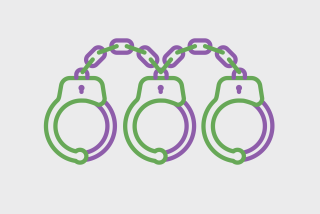Study Sees ‘Gamble’ in Wider Probation for Felons in State
- Share via
Probation, originally designed as a sanction and rehabilitative tool for petty criminals, increasingly is being used in California as a “high-risk gamble” to punish felons who pose a serious threat to public safety, according to a study by the Rand Corp. released Saturday.
Felons now constitute 35% of all adult probationers in the state, Rand found.
The number of adults sentenced to probation from the state’s Superior Courts, which handle felony cases, has increased by 13% over eight years, the researchers said.
But they concluded that the increase is “more alarming” than the figure suggests because “there is some evidence” that felons now being placed on probation “have committed more serious crimes than those who have received probation in the past. . . . And significantly fewer resources are being devoted to their supervision.”
Problem of Prison Space
Rand suggested that judges are placing more felons on probation to reserve scarce prison space for the most serious offenders.
However, the researchers noted that courts do not have a good track record of predicting which serious offenders will do well on probation.
In a project financed by the National Institute of Justice, a Rand team headed by criminologist Joan Petersilia tracked 1,672 male felons who had been placed on probation by courts in Los Angeles and Alameda counties.
The researchers found that during 40 months while most of the felons were on probation, 65% of them were arrested, 51% were convicted and 34% were sentenced to jail or prison for new crimes.
“Felons granted probation represent a serious threat to public safety,” said the Rand researchers, noting that, of those arrested again, 75% were charged with burglary, robbery and other violent crimes, and, of those convicted again, 18% were found guilty of “serious violent crimes”--homicide, rape, weapons offenses, assault and robbery.
“Probation is intended for offenders who pose little threat to society and can, ideally, be rehabilitated through a productive, supervised life in the community,” the researchers said. “. . . We believe it is not an effective . . . sentencing alternative for most felons.”
They noted that the increase in felons on probation “appear(s) to have crowded out the traditional probationer population--first offenders, petty thieves, drug offenders and disrupters. . . .
“Those . . . offenders who present little threat to . . . society . . . rarely get probation any more. Most of them are never charged, much less convicted. Many of them may ultimately become more serious criminals because the system can no longer afford to ‘notice’ their minor crimes. . . .”
Budgets Reduced
Because county probation department budgets have been cut at the same time as those departments have been called upon to supervise more serious offenders, the researchers concluded that “probation appears to be heading toward an impasse, if not a total breakdown,” unless substantially more funds are made available to build prisons.
However, Petersilia, principal author of the study, urged development of alternative punishments to prison or conventional probation.
Conventional probation is a criminal sanction in which the court releases convicted offenders, subject to certain conditions--which, for felons, routinely include time in local jails--as an alternative to terms in state prisons.
“Today it is by far the most frequently used sanction against criminals in this country,” the Rand study said. “(Probation) is imposed in 60% to 80% of (all) criminal court convictions,” and one of every 83 Californians between the ages of 9 and 65 is currently on probation for some offense.
But in some California counties, the average caseload for a probation officer is between 150 and 300 offenders, the researchers found, and, as a result, these officers often “can do no more than hand their charges a stack of postcards to be mailed in at specified intervals,” rather than monitor their activities in person.
“In these instances, probation actually means freedom, with few constraints and little supervision,” the researchers said.
The only present alternative--building more prisons--is expensive.
Petersilia and her co-authors--Susan Turner, James Kahan and Joyce Peterson--argued that “the only way to ease prison overcrowding and safeguard the community is to find alternative means of handling those convicted felons who fall in the gray area between the most serious offenders--who are and should be sentenced to prison--and the very-low-risk offenders who require minimal, if any, community supervision.”
They suggested that authorities look to pilot projects under way in various states--as well as one in Contra Costa County--that provide for closer supervision of selected serious offenders not in custody. Like all probationers, these can be sent to prison if they do not adhere to conditions placed on their release, such as curfews, steady employment and community service.
The annual cost for a probationer in one of these “intensive-surveillance programs” ranges from $2,000 to $5,000--about 10 times the cost of monitoring a probationer in a conventional program. In California, it costs $14,000 each year to maintain an adult in prison, the Rand researchers said.
However, the researchers acknowledged that it is difficult to predict which felony offenders will do well on probation.
“It appears that neither the (probation departments, which make sentencing recommendations to judges) nor the courts have done particularly well in identifying felons who are suitable for probation. . . .
“Using the best statistical models and a wealth of information on offenders, we could not predict recidivism with more than 70% accuracy. Thus, with presently available information and methodologies, offender risk prediction probably cannot be improved dramatically.”
More to Read
Sign up for Essential California
The most important California stories and recommendations in your inbox every morning.
You may occasionally receive promotional content from the Los Angeles Times.









